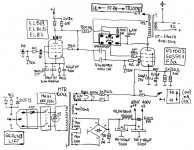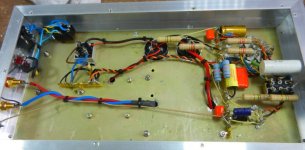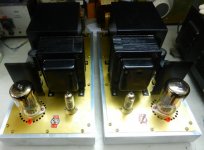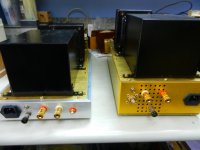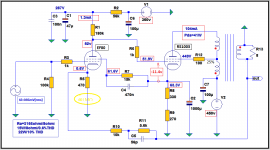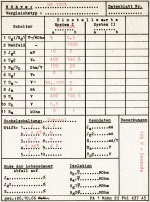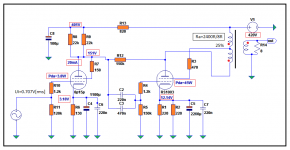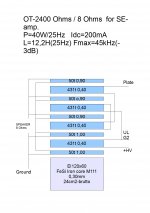Just finished monoblocks with RS1003 ( SRS551) tube in SE-ClassA triode (option UL) connection. For drive tube I use EL803 (EL83 or EL803S) tube in triode connection. Also build in switch for LOW/HIGH output power for spare tube life time. Output power is 11W or 15W in triode connection, and 16W or 22W in UL connection. UL tape is at 25% turns of output transformer (closer to pentode connection), so I must use SHADE-feedback to reduce gain and distorsions.
Attachments
My comment is only about safety.
I notice you lift the connection to Earth at the chassis! This makes it unsafe,
If you want to break ground loops, lift the (-) on the input, nevet the Safety Earth!
I notice you lift the connection to Earth at the chassis! This makes it unsafe,
If you want to break ground loops, lift the (-) on the input, nevet the Safety Earth!
My comment is only about safety.
I notice you lift the connection to Earth at the chassis! This makes it unsafe,
If you want to break ground loops, lift the (-) on the input, nevet the Safety Earth!
On the back side of chassis, there is terminal for separate wire for grounding.
Also, You can see previous version of frame.
Attachments
Sonds very good, more like some other bigger transmitting tubes with direct heating, not like 2-3 paralell connecteed EL34, KT88 or GU50 tubes.
In triode connection sunds like 811A or 812A, but with less distorsion. UL-connection provide much more power, and can drive less sensitive speakers. Less detail than triode connect, but with BIGG sound for rock, metal and simphonical music.
In triode connection sunds like 811A or 812A, but with less distorsion. UL-connection provide much more power, and can drive less sensitive speakers. Less detail than triode connect, but with BIGG sound for rock, metal and simphonical music.
Sonds very good, more like some other bigger transmitting tubes with direct heating, not like 2-3 paralell connecteed EL34, KT88 or GU50 tubes.
In triode connection sunds like 811A or 812A, but with less distorsion. UL-connection provide much more power, and can drive less sensitive speakers. Less detail than triode connect, but with BIGG sound for rock, metal and simphonical music.
Hello!
I love this lamp RS1003 and congratulations for this achievement.
What would be equivalent to EL803, or could be replaced this lamp???
What about the scheme designed by me?
EF80 is galvanic coupling advantage is a very good response in low frequencies.
The disadvantage is that the anode voltage to be coupled after the tubes were heated
Attachments
Just finished monoblocks with RS1003 ( SRS551) tube in SE-ClassA triode (option UL) connection. For drive tube I use EL803 (EL83 or EL803S) tube in triode connection. Also build in switch for LOW/HIGH output power for spare tube life time. Output power is 11W or 15W in triode connection, and 16W or 22W in UL connection. UL tape is at 25% turns of output transformer (closer to pentode connection), so I must use SHADE-feedback to reduce gain and distorsions.
Do you have a link to a spec sheet on this tube? Looks pretty interesting.
Do you have a link to a spec sheet on this tube? Looks pretty interesting.
these data will be helpful?
or equivalent to RS1003 is SRS551 find here:
Scheidig Rhrensammlung: Senderoehren: SRS 551 Letztes Update: Sat Jan 10 13:14:01 2009
Attachments
Last edited:
EF80 is good drive for UL connection output tube, but in triode connection there is much more capacitance (total input capacitance of RS1003~150pF including Miller) , and You need tube with less internal resistance for drive.Hello!
I love this lamp RS1003 and congratulations for this achievement.
What would be equivalent to EL803, or could be replaced this lamp???
What about the scheme designed by me?
EF80 is galvanic coupling advantage is a very good response in low frequencies.
The disadvantage is that the anode voltage to be coupled after the tubes were heated
Good substitute for EL803(S) is EL83, 6CK6, and cheep russian 6P15S. Also new production (actual) is SV83 (SVETLANA).
Gain of output tube in triode connection is ~20-21x, and for normal input sesitivity (~1Veff) You need drive element with total gain about ~12x(including SHADE feedback). You can use 1/2 double-triode tubes(6SN7, 6CG7, 6FQ7, E80CC etc.; russian 6N6P and 6N30P) and many tubes with single triode in sistem with same caracteristic like 6J5GT.
At first, I try with triode connection E80F(~EF86) and 5879 tubes with very good sounds at low power, but more distorsions at higher levels as triode conection output tube. Also try triode connection EL84(6BQ5) and 6BW6(noval version of 6V6). Booth have perfect caracteristic and sound, but too low gain (~6-8x).
You can try 6CL6, caracteristics in triode mode are near EL83, and any video output pentode/tetrode from old B&W-TV sets.
Last edited:
For RS1003 You can find data sheet at Frank's Electron tube Pages.these data will be helpful?
or equivalent to RS1003 is SRS551 find here:
Scheidig Rhrensammlung: Senderoehren: SRS 551 Letztes Update: Sat Jan 10 13:14:01 2009
RS1003 need 2,3A for heating, SRS551 need 2,2A, and F3a need 2,1A. Other caracteristic are the same.
EF80 is good drive for UL connection output tube, but in triode connection there is much more capacitance (total input capacitance of RS1003~150pF including Miller) , and You need tube with less internal resistance for drive.
Good substitute for EL803(S) is EL83, 6CK6, and cheep russian 6P15S. Also new production (actual) is SV83 (SVETLANA).
Gain of output tube in triode connection is ~20-21x, and for normal input sesitivity (~1Veff) You need drive element with total gain about ~12x(including SHADE feedback). You can use 1/2 double-triode tubes(6SN7, 6CG7, 6FQ7, E80CC etc.; russian 6N6P and 6N30P) and many tubes with single triode in sistem with same caracteristic like 6J5GT.
At first, I try with triode connection E80F(~EF86) and 5879 tubes with very good sounds at low power, but more distorsions at higher levels as triode conection outpui tube. Also try triode connection EL84(6BQ5) and 6BW6(noval version of 6V6). Booth have perfect caracteristic and sound, but too low gain (~6-8x).
You can try 6CL6, caracteristics in triode mode are near EL83, and any video output pentode/tetrode from old B&W-TV sets.
Thank you very much for your response and try 6P15P version or even 6P9 (metal cylinder), do you think would be good and D3a??
I like that these days I'll try this version, thanks!
Thank you very much for your response and try 6P15P version or even 6P9 (metal cylinder), do you think would be good and D3a??
I like that these days I'll try this version, thanks!
D3a have gain about 70x in triode mode?!
D3a is fantastic tube for many other aplications, but You do not need D3a here!
Do you have a link to a spec sheet on this tube? Looks pretty interesting.
http://www.mif.pg.gda.pl/homepages/frank/short/054/4/436.pdf
...............................................................................................................................................................Good substitute for EL803(S) is EL83, 6CK6, and cheep russian 6P15S. Also .
We made changes in your schedule for 6P15P and the simulation results are excellent.
Thanks for the advice and I hope to be as sound.
The scheme is this:
I prefer UL pentode configuration, I and some power
Attachments
Last edited:
We made changes in your schedule for 6P15P and the simulation results are excellent.
Thanks for the advice and I hope to be as sound.
The scheme is this:
I prefer UL pentode configuration, I and some power
If You need more power, You can drop katode resistor to 90 Ohms (2x180 Ohms), and katode curent wil grow to 160-165mA, and outpu power to >25W!
At my experiments, I started with 220+150 Ohms in paralel (89 Ohms), and katode curent was 170mA, and output power ~28W!
RS1003 (SRS551 also!) is very robust and constructed for >10000 working hours with 60W plate, and 9W screen disipation! Usualy used in medical instruments (HF-heating), and FM-transmitters (as output tube, and drive tube for stronger transmitters). F3a tubes SIEMENS and TELEFUNKEN produced for German-Post broadband multichanell telefone HF amplifier CCS use.
Some pictures from begining:
Attachments
-
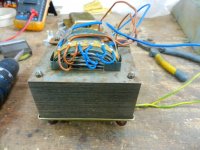 051a.jpg171.6 KB · Views: 1,529
051a.jpg171.6 KB · Views: 1,529 -
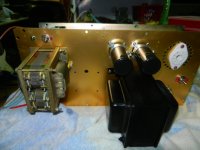 005a.jpg145.7 KB · Views: 1,493
005a.jpg145.7 KB · Views: 1,493 -
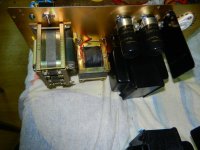 002 (2)c.jpg160.6 KB · Views: 1,480
002 (2)c.jpg160.6 KB · Views: 1,480 -
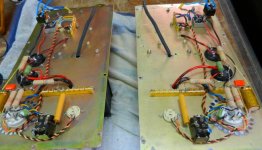 001b.jpg182 KB · Views: 480
001b.jpg182 KB · Views: 480 -
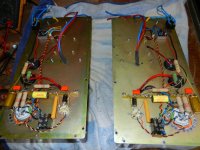 001a.jpg190.7 KB · Views: 1,647
001a.jpg190.7 KB · Views: 1,647 -
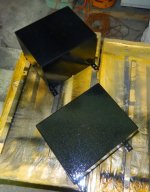 008a.jpg155.5 KB · Views: 419
008a.jpg155.5 KB · Views: 419 -
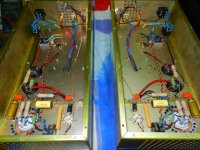 019a.jpg192.2 KB · Views: 431
019a.jpg192.2 KB · Views: 431 -
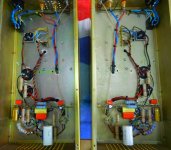 002b.jpg186.7 KB · Views: 389
002b.jpg186.7 KB · Views: 389 -
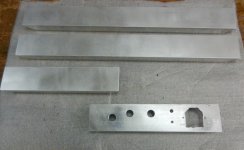 006a.jpg142.9 KB · Views: 368
006a.jpg142.9 KB · Views: 368 -
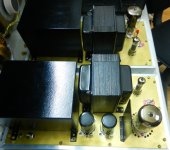 016a.jpg150.9 KB · Views: 485
016a.jpg150.9 KB · Views: 485
great project!
interesting high low switch.
i experimented some years ago with triode pp rs1003 and stopped the project because of partial glowing g2 grid, current was in the range. it stoped only with g2 below 300v- do you have the same issue?
interesting high low switch.
i experimented some years ago with triode pp rs1003 and stopped the project because of partial glowing g2 grid, current was in the range. it stoped only with g2 below 300v- do you have the same issue?
Lights (dark red) from center inside tube is NORMAL for RS1003 tube! No problem with screen voltage over 500V! I must use grid stopers with ferite-pearl for G1 and G2 to prevent oscilations in HF (VHF, UHF, etc.) region, because tube have very high Gm!interesting high low switch.
i experimented some years ago with triode pp rs1003 and stopped the project because of partial glowing g2 grid, current was in the range. it stoped only with g2 below 300v- do you have the same issue?
Now, I am testing RS1003 in experimental PP amp with Ua=900V and UG2=450V, and have no problem (Pout>200W!).
Last edited:
- Status
- Not open for further replies.
- Home
- Amplifiers
- Tubes / Valves
- RS1003 in SE triode-UL monoblocks
